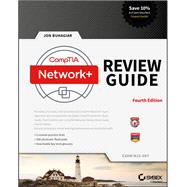Essential last-minute review aid for the updated CompTIA Network+ Exam N10-007
CompTIA Network+ Review Guide Exam N10-007, 4th Edition, is your ideal study companion for preparing for the CompTIA Network+ exam (N10-007). Organized by exam objectives, this is a focused, concise review guide that works hand-in-hand with any learning tool, including the Sybex CompTIA Network+ Study Guide, CompTIA Network+ Deluxe Study Guide, and CompTIA Network+ Practice Tests. The book is broken into 5 parts, each part corresponding to one of the 5 objective domain areas of the Network+ exam: Network Architecture; Network Operations; Network Security; Troubleshooting; and Industry Standards, Practices, and Network Theory. Readers will also be given access to the comprehensive online Sybex test bank, which includes two bonus practice tests, electronic flashcards, and a glossary of terms that you’ll need to know come exam day.
CompTIA's Network+ certification covers advances in networking technology, and reflects changes in associated job tasks. The exam places greater emphasis on network implementation and support, and includes expanded coverage of wireless networking topics. This review guide gives you the opportunity to identify your level of knowledge while there's still time to study, and avoid exam-day surprises.
- Review network architecture and security
- Understand network operations and troubleshooting
- Gain insight into industry standards and best practices
- Get a firmer grasp of network theory fundamentals
If you’re looking for a beginning, vendor-neutral networking certification, look no further than CompTIA Network+.








